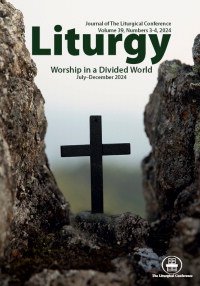In the Current Issue: "Worship in a Divided World"
The issue of Liturgy entitled “Worship in a Divided World,” guest-edited by Benjamin Durheim, seeks to explore where our worshipping communities stand with regard to divisions that have pulled Christian worship patterns in divergent directions both negatively and, especially in recent times, positively as strengths. This excerpt is the first half of his Introduction, offering quick glimpses of several of the essays from a range of scholars whose work helps us to think deeply about context and expected practices as we seek to be one body. –– Melinda Quivik
~ ~ ~ ~ ~
To speak of division can be a dicey endeavor. While it is as universal a human experience as one is likely to encounter (in that human communities rarely exist for long without division working its way into them), “division” in a social sense does not exist in a conceptual, disembodied, theoretical way except as a kind of intellectual placeholder. Rather, division exists by taking on flesh, separating and isolating bodies and communities from one another as it putrefies relationships in the spaces between them. It is as diverse as the persons and communities where it finds expression, sometimes looking like political violence or social unrest, other times like righteous indignation and outrage, and still others like a handed-down malaise that dampens development of loving relationships across manufactured borders. Division takes myriad forms, and the work of addressing it consequently resists straightforward, universalizing analysis.
Put differently, attending to division can often treat it—intentionally or not—simply as a problem to be rectified or a sickness to be healed. Sometimes this is appropriate and necessary, but doing so also tends to instrumentalize the methods and frameworks one might bring to questions of division (“how can my framework fix this?” or “what methods do I have at my disposal to help alleviate this problem?”). With regard to worship, this presents something of a challenge. Worship can be and often is unifying in many senses, but an approach to worship that essentializes unity—reducing communal prayer, praise, and liturgical practice to programming whose sole aim is to produce experiences of togetherness or belonging—risks losing the multivalence of communal encounter with the divine. Worship can indeed resist and address division, but its relevance for doing so depends upon its context, practices, and reception.
Significant recent work has contextualized liturgical, sacramental, and worship interactions with division. For example, Katie Grimes’s book Christ Divided traces the historical roles of baptism and eucharist in buttressing racial divisions in the United States. Shawn Copeland’s landmark text Enfleshing Freedom includes a deep examination of the relationship between eucharist, racism, and solidarity. Layla Karst and David Turnbloom, et al., have each explored the relationship between liturgical practice and divisions caused by the trauma of clergy sexual abuse. Kimberly Hope Belcher has contextualized eucharistic phenomenology within receptive ecumenism, and Brian Flanagan has named the challenge of the sin/holy divide and juxtaposition in liturgical celebration. This list could go on.
~ ~ ~ ~ ~
Benjamin Durheim is an assistant professor of theology at the College of Saint Benedict and Saint John’s University in Minnesota, where he teaches courses in liturgical/sacramental theology and theological ethics. His publications have centered on the intersection between liturgy and ethics as in Christ’s Gift, Our Response (Liturgical Press, 2015) and also articles on social ethics, liturgical and sacramental practice, ecumenism, and rural Christianity.
Benjamin Durheim, “Introduction: Worship in a Divided World,” Liturgy 39, nos. 3–4 (2024): 91–92, https://doi.org/10.1080/0458063X.2024.2369488.
